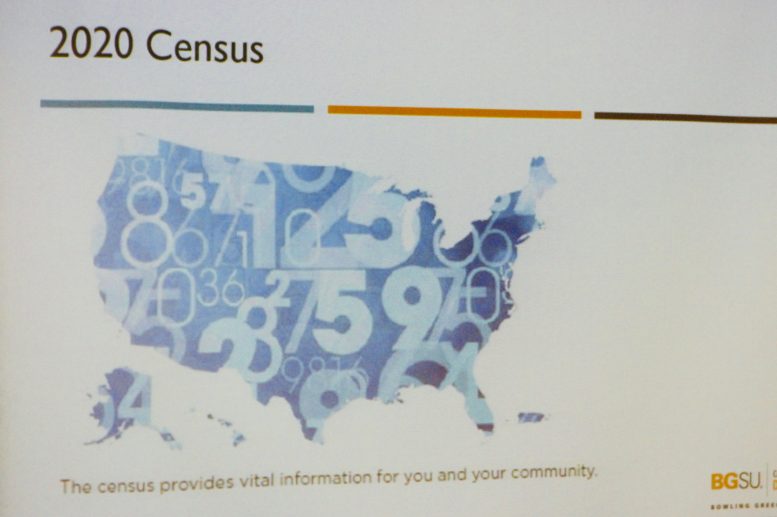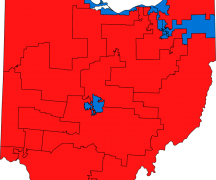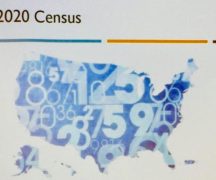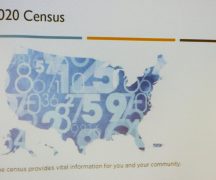By DAVID DUPONT
BG Independent News
Librarians are among Mark Boyd’s favorite people. “We love libraries. They are great partners,” said the partnership specialist with the United States Census Bureau at a Lunch and Learn session sponsored by the Chamber of Commerce Wednesday.
Librarians love the census. Michele Raine, of the Wood County District Public Library, said the Statistical Abstract of the United States is her favorite reference book.
When someone interested in genealogical research asked what happened to the 1890 census data, Boyd and Wendy Manning, a BGSU professor who works extensively with census data, were puzzled.
Three of the librarians in the room, though, chimed in. A fire destroyed the data.
Wood County District Library Director Michael Penrod said librarians’ concern was piqued when the census announced it would be collecting most of its data online.
Librarians know that 25 percent of Americans don’t have access to the internet. Many of them rely on libraries for internet access, and that they will be asking librarians for help.
The census will mail out requests to participate in April. People will be given instructions how to log to complete the form. People will also have the option to get a paper form or to complete the census over the telephone. The Census Bureau will follow up with anyone who does not respond.
When Raine, the director of adult services, asks about concerns about how census data is used, confidentiality, and penalty for not responding, she’s anticipating what patrons will ask.
Boyd made it clear citizens are required to fill out the census form. Refusing to do so or providing false information, carries a $50,000 fine.
Penrod noted that responding to the census is the only requirement of residents that was originally in the Constitution. The requirement to pay taxes was added later.
Back when the census data was first collected in 1790, it was US marshals who collected it, Manning said. Then there were 3,929,214 people in the United States. People had to answer five questions: the number of free white males over 16; the number of free white males under 16; the number of free white females; the number of other free persons who paid taxes; and the number of enslaved people (about 18 percent of the population). When the last census was conducted in 2010 there were 329 million.
The questions asked have shifted over the years. This year when asking about relationships of people within a household, it will include same sex marriage.
It may, depending on how the U.S. Supreme Court rules this month, also include the question: “Is this person a citizen of the United States?”
Janet Jackson May wondered how that question would affect the counting of people in the country without proper documents.
Manning said researchers are concerned about that issue, and how it’ll affect the count.
Boyd said that the census since 1954 is prohibited by Title 13 from sharing any of the information it collects with other agencies, whether it’s the local Job and Family Services office, Internal Revenue Service, or ICE (Immigration and Customs Enforcement).
As Manning noted, though, this was not always the case. Census date was used by the federal government to locate people of Japanese descent, so they could be interred during World War II.
Whether or not the citizenship question is included, Boyd said, the bureau will do its utmost to count everyone.
Manning said this year, college students will be counted for their school residence. The university will help in efforts to collect data.
That shouldn’t be too hard for students living in residence halls. But Boyd said those living in off-campus housing are more difficult to count.
Brooke Harrison, of BG Manor, wondered how people in assisted living will be counted.
Boyd said that residents will be counted where they live, and that special project teams will go out to homes to collect the data.
The census will also start reaching out to find those who are homeless. They will go to shelters, food kitchens, even under bridges to locate people, to try to get them counted.
What’s at stake, Manning said, is the drawing of congressional districts. The number of districts is set in the Constitution, as the population shifts, growing more in one state than in another, the balance in congress shifts. Last time the census was done, Ohio lost two congressional seats, dropping from 18 to 16. This time, it is expected to lose one more.
Also census data helps to make sure federal dollars are properly allocated. And a whole host of other surveys that are important for business and demographers like herself rely in part on the census.





